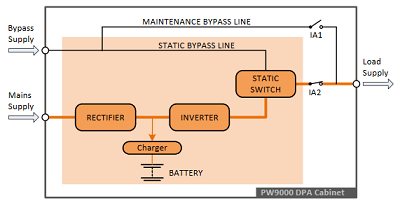Larger data centres are now being commissioned to meet the level of today’s demand for online data processing capacity. Kenny Green is technical support manager at KOHLER Uninterruptible Power Ltd, a KOHLER Company, he looks at how UPS technology has been developed to meet these elevated power demands.
Not all data centres are sized like one particular Google site, which has a reputed capacity of over 45,000 servers. Nevertheless, installations with large, dense populations of servers demanding megawatt power are a reality that must be supported by correspondingly scaled UPS configurations. These must be designed specifically for elevated power levels – but can they retain the UPS benefits currently offered by their smaller counterparts?
UPS installations today, rated at tens or hundreds of kilowatts typically benefit from transformerless design. These use new DSP and power semiconductor technology to eliminate the output transformer seen in earlier medium and high power PWM based UPS systems. The extent of space and weight saving this creates means that UPS units of up to 50kVA can be implemented as 19” rackmounted modules; a single rack with a small footprint can be populated with up to five of these, delivering up to 250kVA. The flexibility of this modular design brings many benefits; now, the advent of products like the KUP KOHLER PW 6000 standalone UPS extends these benefits into the MVA power arena.
The KOHLER PW 6000 uses transformerless design and Energy Saving Inverter Switching (ESIS) to deliver up to 500kVA from a single unit. The power upscaling means that this unit is a floor-standing assembly rather than a slide-in rackmounted module. However, it can deliver its power from a small footprint, ranging from 1.4 m2 down to 0.41m2, depending on rating. This equates to a supplied power density of up to 357 kW/m2.
Up to ten units can be paralleled to support critical loads of up to 5MVA. With 100% capacity sizing that is 5 MW at unity power factor. In the context of these power levels each 500kVA units can be considered as modular. Just like their smaller rackmounted counterparts, their number can be incremented to match the data centre’s growing load. Extra modules can easily be added for N+1, N+2 or greater redundancy. An efficiency of up to 96% minimises operating costs and cooling power demand.
Today’s incessant and continually expanding demand for ‘always on’ processing power has led to data centres with loads of MVA rather than kVA. These loads can now be supplied by large-scale UPS configurations offering the same scalability, resilience, efficiency and other benefits that users have come to expect from their smaller kVA rated systems.





